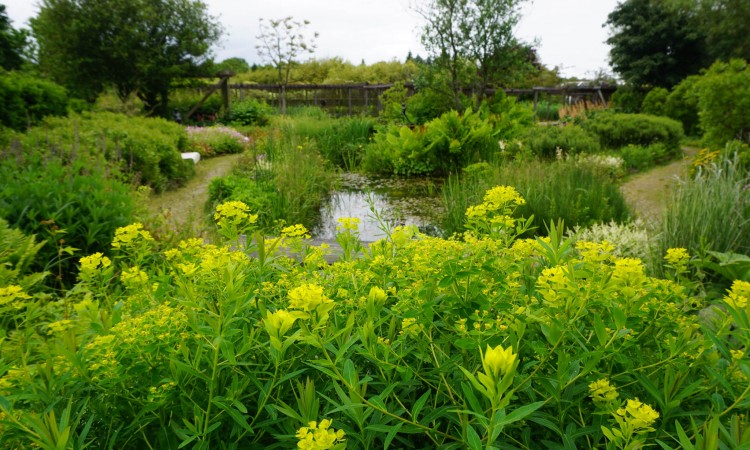
‘Every year it seems as if some arbiter of taste and fashion anoints a member of the vast mint family as “mint of the moment.” Several years ago it was thyme–not just ordinary thyme but lemon thyme, golden thyme, and wooly thyme, not to mention mother-of-thyme. Big name gardeners like Martha Stewart cultivated as many varieties as they could get into the earth. In England Prince Charles turned his attention from public duties and private mayhem to cultivate a “thyme lawn” at his country house. Thyme became more than just a plant and even transcended its time-honored role as a useful herb. It became a status symbol, a carpet, and an all-round must-have item.
Then something similar happened to members of the sage family, with pineapple sage posing as a centerfold one month in Garden Design magazine. Basil, in all its incarnations, also had a long moment in the limelight. By all rights America should have been drowned by a tidal wave of pesto sauce about two years ago.
Somehow perilla (Perilla frutescens) got lost in all the hype. I don’t know why—after all, it’s a member in good standing of the enormous mint family, and it looks for all the world like purple basil. It is no more or less rampant than spearmint or applemint or any of those other briskly flavored herbs. Furthermore, the leaves of the common ornamental variety are dark purple, and anyone who watches horticultural trends will tell you that purple is the new green. Perilla would be right at home in a garden that featured purple-leafed heucheras, pennesetum with purplish “foxtails” and the flashier forms of its relative, coleus.
Perilla may be unheralded in the glossy magazines, but I find it appealing. A friend gave me several small starter plants a year ago, and now their offspring are popping up all over my garden. I don’t mind that. Yesterday when I wanted to edge the long bed by my garage, and had no desire to make a trip to the garden center, I dug up a number of perilla seedlings and planted them along the length of the bed. In a month’s time I will have quite an acceptable edging at absolutely no expense.
Several reference sources refer to perilla’s flowers as “insignificant”. This is clearly an example of damning with faint praise. Like most mints, perilla sends up flower stalks covered with tiny blossoms. In the case of my perilla, the blossoms are pink. They look quite lovely against the purple foliage, and they attract bees, butterflies and anything else that happens to be flying through the neighborhood. I count all those things as positives, but if you are less than enchanted by the flowers, cut off the stalks when they appear. The only time I perform this surgery is when I am going to use the perilla flowers in small arrangements.
Perilla is sometimes called “beefsteak plant”, and I assume that the name comes from the somewhat beefy color of the leaves. The foliage has a pleasantly fruity fragrance that reminds some people of root beer.
In Asia, where perilla originated, the plant has many names and a host of uses. The name that is most familiar to westerners is the Japaneses–“shiso”. When perilla is grown commercially, the oil extracted from its seeds is used for cooking or as a “drying oil”, similar to linseed oil, to provide a protective finish on wood or other surfaces. Both the seeds and the foliage can be eaten, and in Japan the leaves of the red-leafed variety are used in the production of pickled plums and plum sauce. The plant is also used in traditional Asian herbal medicine as a treatment for conditions ranging from coughs to seafood poisoning.
So why is perilla so underused in the United States? Other than a tendency towards rampant growth, the plant has only one drawback, and that is its toxicity to cattle. My reference sources suggest that in the normal course of events, cattle will avoid perilla, which apparently grows wild in parts of the southeastern United States. If, however, the dried plants are mixed into hay used as cattle feed and ingested by cows, the animals will die. Perilla is not toxic to other species, including pigs and dogs, though it is possible that deer and other undesirables might avoid it. This is something to consider if members of the peaceable kingdom are snacking regularly on your prized plants.
So, unless you are raising cattle on the north forty, perilla might be just right as an agreeable garden ornamental. It self sows readily, but if you don’t want the seedlings, they are easy to pluck out. On the other hand, you could pot up your extra perilla and give the young plants to gardening friends. You might start a fashion trend.

Cara
See https://www.invasive.org/alien/pubs/midatlantic/pefr.htm before intentionally planting Perilla frutescens. “Once established, it disrupts native ecosystems by pushing out native plants.”
Please…whenever possible, choose plants that are native to your area. I’ve seen firsthand the effects of this and other invasive plants on our local woodlands.